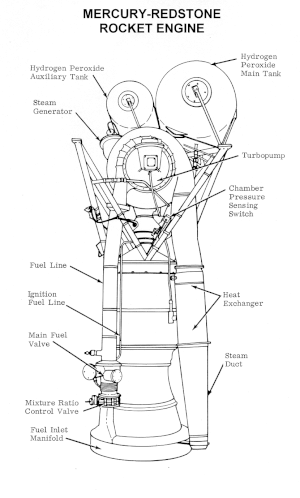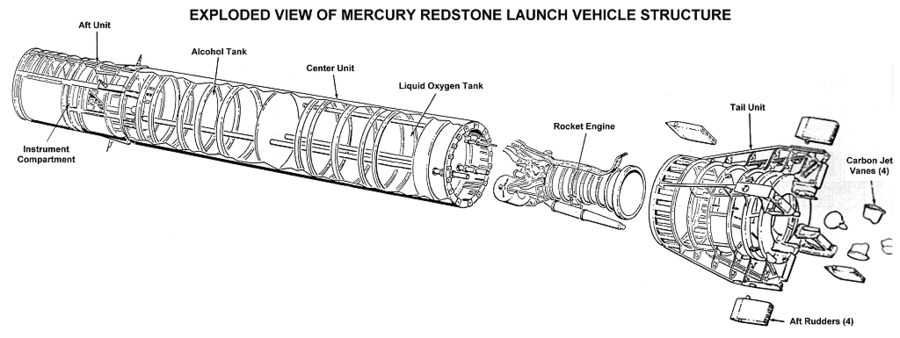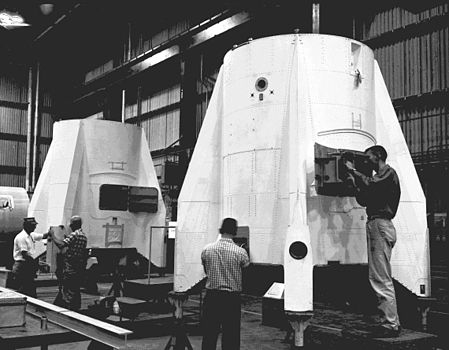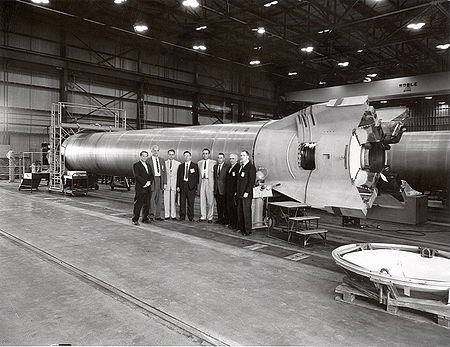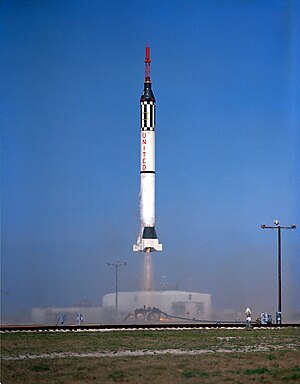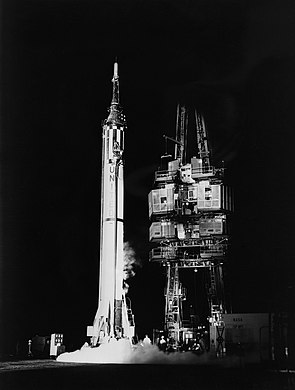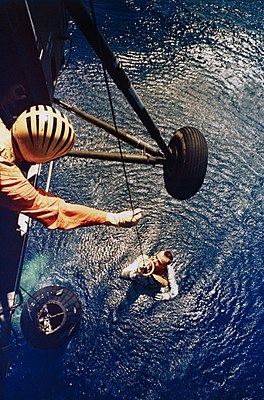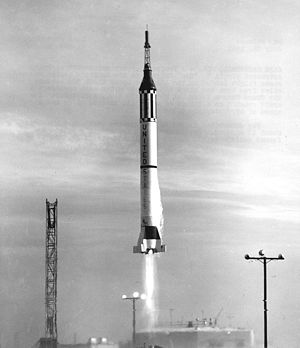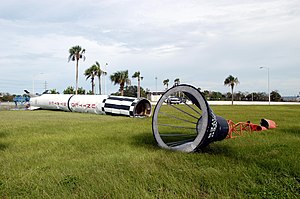Mercury-Redstone booster gallery
Booster construction and testing[edit]
-
Technicians preparing Mercury-Redstone booster tail sections at Redstone Arsenal, Huntsville, Alabama, in 1959.
-
Astronauts and other officials in front of a Mercury-Redstone booster at NASA's Marshall Space Flight Center in Huntsville, circa 1960.
A Mercury capsule is mounted on a Mercury-Redstone booster, prior to test firing at Marshall Space Flight Center's Redstone Test Stand, circa 1960.
Unmanned Mercury-Redstone launches[edit]
Mercury-Redstone 1[edit]
Mercury-Redstone 1, the first attempt to launch a Mercury-Redstone, on November 21, 1960, failed in a quite peculiar fashion.
-
Preparations to launch Mercury-Redstone 1 at Cape Canaveral's Launch Complex 5.
-
At 8:59 AM EST, the booster's engine is ignited.
-
Moments later, while the booster umbilical is still falling toward the ground, an electrical fault causes the booster's engine to shut down and triggers the Mercury capsule's escape rocket to jettison itself. The booster rises only 4 inches before settling back onto the pad, and the capsule remains attached to the booster.
Mercury-Redstone 2 and Mercury-Redstone Booster Development[edit]
-
Mercury-Redstone 2 launches at 11:54 AM EST on January 31, 1961, carrying the chimpanzee "Ham", the first higher primate to fly into space.
-
Mercury-Redstone Booster Development (MR-BD) lifts off at 12:30 PM EST on March 24, 1961. This was a booster test flight with a dummy "boilerplate" capsule.
-
Another photo of the MR-BD launch. The truck in the foreground was there as a test. Manned Mercury-Redstone flights were supposed to have a "cherry-picker" vehicle near the rocket to provide an emergency escape route for the astronaut. The truck acted as a stand-in for the cherry-picker to determine whether it might be damaged by rocket blast.
Mercury-Redstone 3 (Freedom 7)[edit]
Mercury-Redstone 3 ("Freedom 7"), the first U.S. human space flight, was launched on May 5, 1961, at 9:34 AM EST. It carried astronaut Alan Shepard on a 15-minute sub-orbital flight which reached a height of 116 miles (187 km) and landed 302 miles (486 km) from the launch site.
Prelaunch activities[edit]
-
The "cherry-picker" seen here, officially known as the "mobile aerial tower", acted as an emergency escape route for the astronaut before launch. Its cab would be positioned next to the capsule hatch during the period preceding the launch.
-
Astronaut escape testing with the cherry-picker.
-
Nighttime preparations for the launch.
Launch[edit]
-
The booster ignites as its umbilical mast drops. The mist around the tail is formed by the frigid liquid oxygen entering the engine during ignition.
-
The mist cloud spreads as the engine's thrust builds up.
-
Freedom 7 lifts off. The engine's thrust has dissipated the mist. The exhaust plume is very pale because the engine burns ethyl alcohol fuel.
-
The cab of the yellow cherry-picker had been retracted just before launch.
-
Another angle.
-
The red service structure in this view ran on railroad tracks and was withdrawn to the edge of the pad before launch. Note the flames around the launch stand and the flame deflector beneath it.
-
"Shock diamonds" are visible in the exhaust plume. The umbilicals for the capsule and booster can be seen lying beside the launch stand.
-
Climbing into the heavens.
Mercury-Redstone 4 (Liberty Bell 7)[edit]
Mercury-Redstone 4 ("Liberty Bell 7") was the second U.S. human space flight. It was launched on July 21, 1961 at 7:20 AM EST, carrying astronaut Gus Grissom to a height of 118 miles (190 km) and landing 302 miles (486 km) from the launch site.
Launch preparations[edit]
-
Erecting the booster for Mercury-Redstone 4.
-
Shown here is an earlier attempt to launch Mercury-Redstone 4 on July 19 which was scrubbed due to weather. In this picture the cherry-picker cab is still next to the capsule hatch.
Launch[edit]
Display booster at Kennedy Space Center[edit]
Mercury-Redstone booster MR-6 was a production booster that was never launched. Instead it was erected as a permanent display at the Visitor Information Center at Kennedy Space Center (KSC), near Cape Canaveral. The booster stood for many years, until it was toppled by Hurricane Frances in September 2004. As of 2009, MR-6 is in storage awaiting repair.
-
Booster MR-6 on display at KSC in 1966.
-
Another view of MR-6 at KSC later that year.
-
MR-6 in the wake of Hurricane Frances.
-
rocket launch
Technical drawings[edit]

